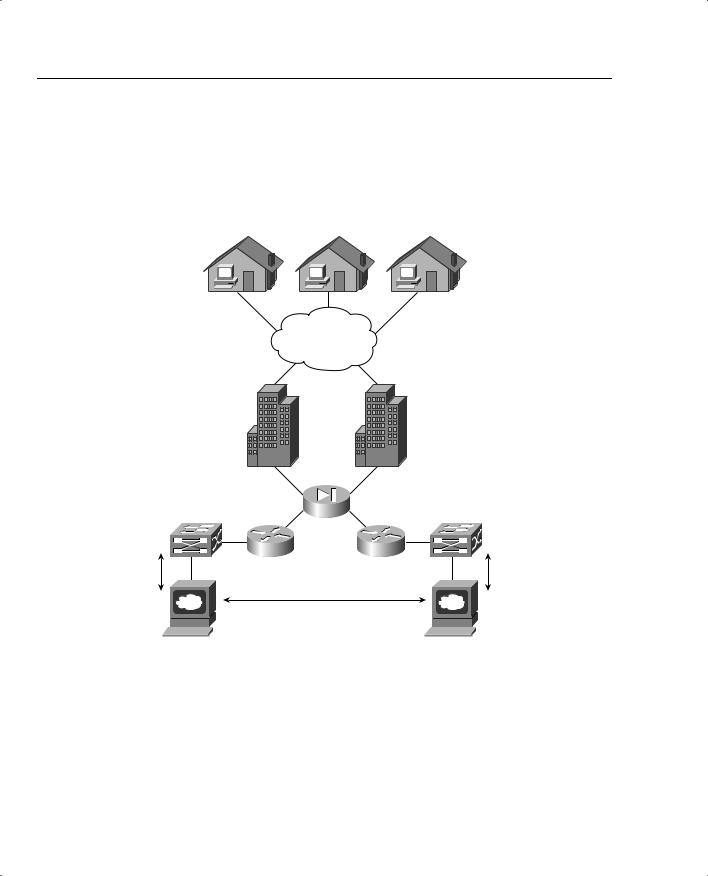
- •CCIE Security Written Exam Blueprint
- •General Networking Topics
- •“Do I Know This Already?” Quiz
- •Foundation Topics
- •Networking Basics—The OSI Reference Model
- •Ethernet Overview
- •Internet Protocol
- •Variable-Length Subnet Masks
- •Classless Interdomain Routing
- •Transmission Control Protocol
- •TCP Services
- •Routing Protocols
- •ISDN
- •IP Multicast
- •Asynchronous Communications and Access Devices
- •Foundation Summary
- •Requirements for FastEther Channel
- •Scenario
- •Scenario 2-1: Routing IP on Cisco Routers
- •Scenario Answers
- •Scenario 2-1 Answers: Routing IP on Cisco Routers
- •Application Protocols
- •“Do I Know This Already?” Quiz
- •Foundation Topics
- •Domain Name System
- •Trivial File Transfer Protocol
- •File Transfer Protocol
- •Hypertext Transfer Protocol
- •Secure Socket Layer
- •Simple Network Management Protocol
- •Simple Mail Transfer Protocol
- •Network Time Protocol
- •Secure Shell
- •Foundation Summary
- •Scenario
- •Scenario Answers
- •Scenario 3-1 Solutions
- •“Do I Know This Already?” Quiz
- •Foundation Topics
- •Cisco Hardware
- •show and debug Commands
- •Password Recovery
- •Basic Security on Cisco Routers
- •IP Access Lists
- •Foundation Summary
- •Scenario
- •Scenario Answers
- •Security Protocols
- •“Do I Know This Already?” Quiz
- •Foundation Topics
- •Authentication, Authorization, and Accounting (AAA)
- •Remote Authentication Dial-In User Service (RADIUS)
- •Kerberos
- •Virtual Private Dial-Up Networks (VPDN)
- •Encryption Technology Overview
- •Internet Key Exchange (IKE)
- •Foundation Summary
- •Scenario
- •Scenario 5-1: Configuring Cisco Routers for IPSec
- •Scenario Answers
- •Scenario 5-1 Solutions
- •“Do I Know This Already?” Quiz
- •Foundation Topics
- •UNIX
- •Microsoft NT Systems
- •Common Windows DOS Commands
- •Cisco Secure for Windows and UNIX
- •Cisco Secure Policy Manager
- •Cisco Secure Intrusion Detection System and Cisco Secure Scanner
- •Cisco Security Wheel
- •Foundation Summary
- •Scenarios
- •Scenario 6-1: NT File Permissions
- •Scenario 6-2: UNIX File Permissions
- •Scenario Answers
- •Scenario 6-1 Solution
- •Scenario 6-2 Solution
- •Security Technologies
- •“Do I Know This Already?” Quiz
- •Foundation Topics
- •Advanced Security Concepts
- •Cisco Private Internet Exchange (PIX)
- •Cisco IOS Firewall Security Feature Set
- •Public Key Infrastructure
- •Virtual Private Networks
- •Foundation Summary
- •Scenario
- •Scenario Answer
- •Scenario 7-1 Solution
- •“Do I Know This Already?” Quiz
- •Foundation Topics
- •Network Security Policies
- •Standards Bodies and Incident Response Teams
- •Vulnerabilities, Attacks, and Common Exploits
- •Intrusion Detection System
- •Protecting Cisco IOS from Intrusion
- •Foundation Summary
- •Scenario
- •Scenario 8-1: Defining IOS Commands to View DoS Attacks in Real Time
- •Scenario Answer
- •Scenario 8-1 Solution

Common Windows DOS Commands 295
Common Windows DOS Commands
The following are some of the most widely used DOS operating commands in Windows environments along with sample displays:
• ipconfig—Displays IP address and subnet mask:
C:\>ipconfig
Ethernet adapter Local Area Connection:
Connection-specific DNS Suffix |
. : |
cisco.com |
IP Address. . . . . . . . . . . |
. : |
150.100.1.253 |
Subnet Mask . . . . . . . . . . |
. : |
255.255.255.0 |
Default Gateway . . . . . . . . |
. : |
150.100.1.240 |
•ipconfig /all—Displays more detailed information about TCP/IP configurations, such as DNS and domain names:
C:\>ipconfig /all
Windows 2000 IP Configuration
Host Name . . . . . . . . . . . . : c03298157693425
Primary DNS Suffix . . . . . . . : cisco.com
Node Type . . . . . . . . . . . . : Hybrid
IP Routing Enabled. . . . . . . . : No
WINS Proxy Enabled. . . . . . . . : No
DNS Suffix Search List. . . . . . : cisco.com
Ethernet adapter Local Area Connection:
Connection-specific DNS Suffix |
. : |
cisco.com |
Description . . . . . . . . . . |
. : |
3Com 10/100 Mini PCI Ethernet Adaptr |
Physical Address. . . . . . . . |
. : |
00-00-86-48-7B-35 |
DHCP Enabled. . . . . . . . . . |
. : No |
|
IP Address. . . . . . . . . . . |
. : 150.100.1.253 |
|
Subnet Mask . . . . . . . . . . |
. : 255.255.255.0 |
|
Default Gateway . . . . . . . . |
. : 150.100.1.240 |
|
DNS Servers . . . . . . . . . . |
. : 64.104.200.116 |
|
|
|
171.68.10.70 |
Primary WINS Server . . . . . . |
. : 64.104.193.200 |
|
• arp –a—Displays ARP entries on the local machine:
C:\>arp -a
Interface: 150.100.1.253 on Interface 0x1000003
Internet Address |
Physical Address |
Type |
150.100.1.240 |
00-60-09-c4-34-17 |
dynamic |
150.100.1.254 |
00-b0-64-46-a8-40 |
dynamic |
• hostname—Displays the local host name:
C:\>hostname c03298157693425
•nbtstat—Displays the NetBIOS over TCP/IP statistics. A number of options are displayed:
C:\>nbtstat
Displays protocol statistics and current TCP/IP connections using NBT (NetBIOS over TCP/IP).

296 Chapter 6: Operating Systems and Cisco Security Applications
NBTSTAT [ [-a RemoteName] [-A IP address] [-c] [-n] [-r] [-R] [-RR] [-s] [-S] [interval] ]
-a |
(adapter status) |
Lists |
the remote machine's name table given its name |
|
-A |
(Adapter status) |
Lists |
the remote machine's name table given its |
|
|
|
|
IP address. |
|
-c |
(cache) |
|
Lists |
NBT's cache of remote [machine] names and their |
|
|
|
IP addresses |
|
-n |
(names) |
|
Lists |
local NetBIOS names. |
-r |
(resolved) |
Lists |
names resolved by broadcast and via WINS |
|
-R |
(Reload) |
|
Purges and reloads the remote cache name table |
|
-S |
(Sessions) |
Lists |
sessions table with the destination IP addresses |
|
-s |
(sessions) |
Lists |
sessions table converting destination IP |
|
|
|
|
addresses to computer NETBIOS names. |
|
-RR |
(ReleaseRefresh) |
Sends |
Name Release packets to WINs and then starts |
|
|
|
|
Refresh |
|
RemoteName |
Remote host machine name. |
|||
IP address |
Dotted decimal |
representation of the IP address. |
||
interval |
Redisplays selected statistics, pausing interval seconds |
|||
|
|
between each display. Press Ctrl+C to stop redisplaying |
||
|
|
statistics. |
|
|
•ping—Provides a means to test and verify remote locations. An example ping to www.cisco.com follows:
C:\>ping www.cisco.com
Pinging www.cisco.com [198.133.219.25] with 32 bytes of data:
Reply from 198.133.219.25: bytes=32 time=182ms TTL=248
Reply from 198.133.219.25: bytes=32 time=180ms TTL=248
Reply from 198.133.219.25: bytes=32 time=180ms TTL=248
Reply from 198.133.219.25: bytes=32 time=181ms TTL=248
Ping statistics for 198.133.219.25:
Packets: Sent = 4, Received = 4, Lost = 0 (0% loss),
Approximate round trip times in milli-seconds:
Minimum = 180ms, Maximum = 182ms, Average = 180ms
C:\>
•tracert—Provides a method to list next hop addresses for remote networks. The following is a sample Windows output when tracert routing to the URL www.smh.com.au:
C:\>tracert www.smh.com.au |
|
|
|
|||||
Tracing route to smh.com.au |
[203.26.51.42] |
|
||||||
over a maximum of 30 hops: |
|
|
|
|||||
1 |
<1 ms |
<1 ms |
<1 |
ms |
c6k-bbn1-vlan105.cisco.com [64.105.208.2] |
|||
2 |
<1 ms |
<1 ms |
<1 |
ms |
c6k-bbn1-msfc-v161.cisco.com [10.66.2.2] |
|||
3 |
<1 ms |
<1 ms |
<1 ms |
sydneycisco-wall-1-f0-1.cisco.com [10.166.128.15] |
||||
4 |
41 |
ms |
236 |
ms |
<1 |
ms |
telstra-gw.cisco.com [103.141.98.141] |
|
5 |
1 |
ms |
1 |
ms |
<1 |
ms |
FastEthernet6-1-0.chw12.Sydney.telstra.net |
|
[149.130.85.3] |
|
|
|
|
|
|
||
6 |
1 |
ms |
1 |
ms |
1 |
ms |
FastEthernet1-0-0.ken4.Sydney.telstra.net |
|
[203.50.19.14] |
|
|
|
|
|
|
||
•route—Provides a method to define static routing entries (Windows NT supports RIP and 2000 supports OSPF). The following example adds a static route for the network 150.100.100.0/24 via the next hop address 131.108.1.1:
c:\>route add 150.100.100.0 mask 255.255.255.0 131.108.1.1

Cisco Secure for Windows and UNIX 297
•nslookup—Provides a DNS query for any host names. The following displays the use of nslookup for the host name www.cisco.com:
C:\>nslookup www.cisco.com
Server: dns-sydney.cisco.com
Address: 64.104.200.248
Name: www.cisco.com
Address: 198.133.219.25
Cisco Secure for Windows and UNIX
Cisco Systems has developed a number of scalable security software products to help protect and ensure a secured network in relation to Cisco products.
Cisco Secure Access Control Server (ACS), commonly referred to as Cisco Secure, provides additional network security when managing IP networks designed with Cisco devices.
Cisco Secure can run on Windows NT/2000 and UNIX platforms.
Three versions of Cisco Secure are listed here:
•Cisco Secure ACS for NT—This powerful ACS application for NT servers runs both TACACS+ and RADIUS. It can use NT username/password database or Cisco Secure ACS database.
•Cisco Secure ACS for UNIX—This powerful ACS application for UNIX includes support for TACACS+ and RADIUS. It supports SQL applications such as Oracle and Sybase.
•Cisco Secure Global Roaming Server—This performs TACACS+ and RADIUS proxy functions. It is a standalone server for large ISP networks.
NOTE Cisco also has a UNIX-based freeware TACACS+ server available for download.
NOTE Cisco Secure topics are tested in the CCIE Security lab exam (particularly Cisco Secure for Windows 2000 server). The written exam does not require you to have a detailed understanding of this application.
The main features of Cisco Secure ACS include the following:
•Supports centralization of AAA access for all users, including routers and firewalls
•Can manage Telnet access to routers and switches

298Chapter 6: Operating Systems and Cisco Security Applications
•Can support an unlimited number of network access servers
•Supports many different Cisco platforms, including PIX access servers and routers
Figure 6-3 displays a typical centralized Cisco Secure ACS performing functions such as user authentication, authorization, and accounting.
Figure 6-3 Cisco Secure Example
ISDN/PSTN
|
PIX |
Ethernet Switch |
Ethernet Switch |
TACACS+/ |
TACACS+/ |
RADIUS |
RADIUS |
|
Cisco Secure NT/UNIX |
Figure 6-3 displays a typical application where ISDN/PSTN users are authenticated by RADIUS or TACACS+ via the Cisco Secure ACS server.
In addition to simultaneous support for RADIUS/TACACS+, Cisco Secure also supports the following AAA features:
•TACACS+ support for the following:
—Access lists
—Privilege level support
—Time restrictions where access to network is controlled during the day and night
